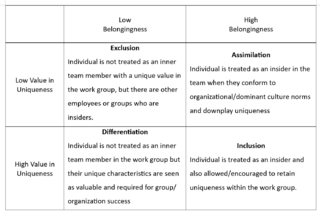Addressing diversity and inclusion in project management
Abstract
The principles of diversity and inclusion (D&I), although often neglected in project management, are crucial to the success of the project. Taking these principles into account offers many advantages, from better performance and innovation to a more pleasant working environment.
Although the themes of D&I re covered in other articles, they are regularly studied from a team perspective (http://wiki.doing-projects.org/index.php/Diversity_in_teams). However, to my knowledge, no comprehensive guide for a project manager to address these issues in a project. This guide will try to give all the resources for a project manager who has to lead a project with a new team and with limited time. For the coherence of the article, a time limit of six months will be set.
While inclusion and diversity policies are substantive and therefore long-term policies, the following article aims to propose effective short-term solutions, which are best suited for project management. Indeed, project management presents unique diversity and inclusion challenges due to the typically tight schedule and temporary nature of the teams.
The article begins by explaining the importance and benefits of diversity and inclusion, while providing a theoretical framework. It will then try to provide a tool to give strategies for taking diversity and inclusion into account in project management, and how to monitor and evaluate its implementation. Finally, the article will discuss the limitations of the approach.
Contents |
Theory
What is Diversity and Inclusion ?
Diversity refers to the presence of difference backgrounds, experiences, and perspective in a team. The most well known examples of diversity are gender diversity, age diversity, ethnic diversity, physical ability and neurodiversity… An even broader definition can be adopted, according to Nobel Prize winner Richard Thaler “We tend to think about that in terms of things like racial diversity and gender diversity and ethnic diversity. Those things are all important. But it’s also important to have diversity in how people think.” [1]
Inclusion refers to the active involvement and equal treatment of all team members. According to McKinsey & Company [1], an inclusive workspace is one that takes into account all employees individually while allowing them to have a significant impact.
Furthermore, the aspects of diversity and inclusion are fundamentally linked; it makes no sense to have a diverse workspace if minorities do not feel included.
Benefits of Diversity and Inclusion
Improves performance
Diversity within the team allows for a variety of ideas, skills and fresh ideas, and even, as we have defined it, a variety of ways of thinking. Diversity brings multiple perspectives when dealing with a problem; if it is difficult for one team member to solve a problem, another member, who will think differently, will certainly find an innovative solution not yet considered. According to a study of over 1,000 large companies [1] , there is a correlation between company performance and diversity.
Also, as the article seems to point out, inclusion is the cornerstone of diversity. Inclusion allows all team members to be equally involved in the decision-making process. This leads to more balanced decisions, avoiding bias and potential errors. It has also been shown, through studies [2], that a sense of inclusion increases individual and collective performance within a project.
Fosters innovation
Diversity brings new ideas and encourages creativity. The interaction between project members stimulates questioning of guidelines and critical thinking, which encourages innovation. According to the material provided for the second week's course (People-slides-Jan-2023), through diversity “different perspectives can create innovative ideas and consider a wider range of possibilities”. Inclusion encourages the exchange of these different views, stimulates creative thinking and promotes innovation.
Well-being of project members
Ongoing studies show [2] that inclusion is linked to both employee satisfaction and turnover intentions; employees who feel included tend to stay longer with the company. With regard to diversity, it has been shown [1] that in Latin America, companies that are more open to diversity are 75% more likely to adopt a pro-teamwork culture. These results are highly questionable and require further study. For the time being, we can only observe a trend without any real indisputable scientific proof.
Theoretical Frameworks

Application
Limitations
Annotated bibliography
- ↑ 1.0 1.1 1.2 1.3 McKinsey & Company. What is diversity, equity, and inclusion (DE&I)? McKinsey & Company. 2022 Aug 17. Available from: https://www.mckinsey.com/featured-insights/mckinsey-explainers/what-is-diversity-equity-and-inclusion. This article explains the definitions and differences between diversity, equity, and inclusion (DE&I), as well as why they matter for organizations today. The article also provides examples of how organizations can implement DE&I strategies across various dimensions, such as talent management, customer engagement, social responsibility, and innovation.
- ↑ 2.0 2.1 Shore, L. M., Randel, A. E., Chung, B. G., Dean, M. A., Ehrhart, K. H., & Singh, G. (2011). Inclusion and Diversity in Work Groups: A Review and Model for Future Research. Journal of Management, 37(4), 1262-1289. Link This paper presents a comprehensive review of diversity and inclusion in working groups, providing an overview of the benefits and challenges associated with these concepts.
- ↑ Cite error: Invalid
<ref>tag; no text was provided for refs namedRef3